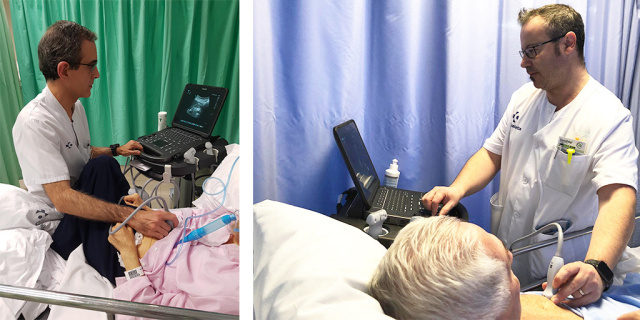
The rapid scanning and dynamic imaging capabilities offered by point-of-care ultrasound make it an invaluable tool for emergency medicine. Dr. Enrique Ortiz Villacian (from Emergency Services at Donostia University Hospital in San Sebastián) and Dr. Juajo Zafra Sanchez (from the Emergency Unit at San Eloy Hospital in Barakaldo) discussed the role ultrasound plays in their respective emergency departments, as well as their formation of an ultrasound training program SonoNorte for clinicians across northern Spain and further afield.

The emergency department at Donostia University Hospital was an early adopter of POCUS, as Dr. Ortiz explained:
“We acquired a Sonosite S-FAST, which was very intuitive to use and easy to move around the department. We soon needed a second system to cope with the number of patients we were scanning. We purchased another S-FAST but, to extend our capabilities further, we realized we needed a system that had multiple transducers that we could switch between quickly and easily. We looked at a number of brands, but nothing else was as robust or easy to clean as the Sonosite instruments, and Sonosite offered a five-year warranty. In the end, we bought two Edge II systems equipped with linear, cardiac, and abdominal transducers, and I now use ultrasound for almost everything! It allows you to rapidly triage patients with complete confidence, shortening waiting times and allowing you to quickly focus on a patient’s underlying condition, as well as performing ultrasound-guided anesthesia. It also gives patients more confidence, as you can show them the problem on the screen.”
“I would certainly enjoy my job less without POCUS,” added Dr. Zafra.
“It is extremely useful as an extension of our clinical examination. For example, you can use it to quickly identify and understand pathologies in pregnant women or children without having to expose them to X-ray radiation. I originally chose an S-FAST because it was very easy to learn to use and offered great image quality. It also starts up very quickly, which is crucial in an emergency situation. We have since upgraded to the latest Edge II system with three transducers.”
Effective, application-specific training is crucial to the success of ultrasound in any medical setting. Both Drs. Ortiz and Zafra are dedicated to broadening the use of POCUS across northern Spain and came together to develop the SonoNorte initiative. Dr. Ortiz explains: “We formed a local working group—EcoSemes Euskadi in the Basque Country—and began a regular POCUS podcast together on YouTube.”
Dr. Zafra adds,
“We were interested in the innovative approaches to teaching POCUS that were beginning to appear in North America, using both YouTube channels and face-to-face courses, and we wanted to put together something that would allow us to share these techniques with colleagues. We liked the idea of an American-style residential course, as this combined theory and hands-on practice with informal ultrasound training opportunities, so we started a collaboration with coordinators of work groups in Cantabria and Asturias and developed the intermediate sonography course SonoNorte.”
“We now run the course every year,” Dr. Ortiz added.
“There are 30 places available, with six trainers who are experts in emergency ultrasound. Hands-on training is an important part of the course, and we always use Sonosite systems. Sonosite is very supportive, supplying as many instruments as we require, and we are lucky that the local Sonosite representative also joins us, helping to answer any technical questions students may have. This highlights the company’s commitment to ultrasound training, as well as its general approach; Sonosite doesn’t just sell you the equipment, it provides the knowledge, training, and maintenance to use it effectively!”
Read More Stories of Sonosite Ultrasound Systems in Spain
POCUS Profile: Dr. Fidel Fernandez
